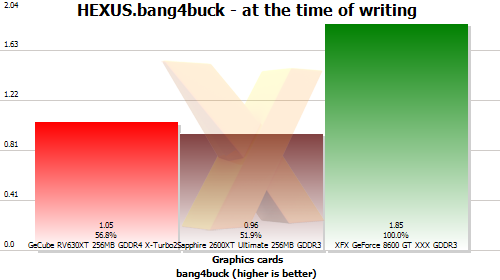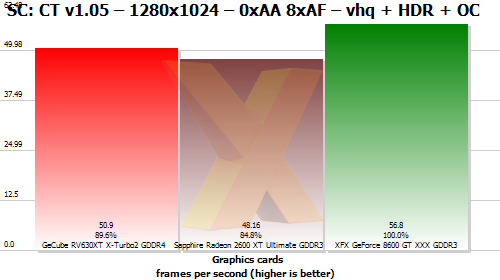HEXUS.bang4buck, overclocking and temperatures
HEXUS.bang4buck
| Graphics cards | GeCube Radeon RV630XT 256MiB GDDR4 X-Turbo2 | Sapphire HD 2600XT Ultimate 256MiB GDDR3 | XFX GeForce 8600 GT XXX GDDR3 |
|---|---|---|---|
| Actual aggregate marks at 1280x1024 4xAA 8xAF | 119.27 | 107.8 | 169.26 |
| Aggregate marks, normalised*, at 1280x1024 | 88.91 | 71.7 | 157.51 |
| Current price | £85 | £70 | £85 |
| HEXUS.bang4buck score | 1.05 | 0.96 | 1.85 |
| Acceptable framerate (av. 60fps) at 1280 x 1024 4x AA 8x AF | No | No | No |
* The normalisation refers to taking playable framerate into account. Should a card benchmark at over 60 frames per second in any one game, the extra fps count as half. Similarly, should a card benchmark lower, say at 40fps, we deduct half the difference from its average framerate and the desired 60fps, giving it a bang4buck score of 30 marks. The minimum framerate, then, can be 20fps, as that will score 0.
As an example, should a card score 120fps we treat it as 90fps (120 - (120-60)/2) as only half the framerate above 60fps is counted for the bang4buck. Similarly, should it score 30fps, we count it as only 15fps (30 + (30-60)/2).
The reasoning behind such calculation lies with playable framerates.
Should card A score 110fps in a benchmark and card B 160, then card B would normally receive an extra 50 marks in our bang4buck assessment, even though both cards produce perfectly playable framerates and anything above 60fps is a bonus and not a necessity for most.
However, the bang4buck total would be identical if in another benchmark card A scored a smooth 70fps and card B an unplayable 20fps, as both aggregate to 180 marks, yet the games-playing experience would be vastly different.
But you would, on balance, say that card A was better because it ran smoothly in both games - and in our revised aggregation, card A would receive 150 marks (85 + 65) and card B 100 (100 + 0).
In effect, we're including a desired average framerate, in this case 60, and penalising lower performance while giving framerates higher than 60fps only half as much credit as those up to 60fps. If this doesn't make sense or you have issue with it, please hit the HEXUS community.

The reason why both the Radeons' HEXUS.bang4buck looks so poor is down to their sub-standard performance in Far Cry. The Radeons are heavily penalised for not being able to render anything close to 60fps. In contrast, the GeForce 8600 GT XXX is in the low 50s - making the game a whole lot more playable. This metric doesn't of course take account of non-3D features such as Avivo HD.
Overclocking
We managed to raise the GeCube's default clocking of 796.5/2196 to 857.25/2286. The Sapphire card was also stable at the same 857.25MHz core speed but its GDDR3 memory topped out at 1602MHz. We re-ran Splinter Cell: Chaos Theory at 1280 x 1024 with 8x AF and HDR and included the overclocked numbers (702/1740) from the XFX card, too.
Strangely, the Radeon-based cards show remarkably little increases in performance when subject to overclocking.
Temperatures
| Graphics cards | GeCube Radeon RV630XT 256MiB GDDR4 X-Turbo2 | Sapphire HD 2600XT Ultimate 256MiB GDDR3 | XFX GeForce 8600 GT XXX GDDR3 |
|---|---|---|---|
| Ambient temperature | 21.5° | 20.5° | 19°C |
| Idle temperature | 55°C | 57°C | 48° |
| Load temperature | 61°C | 61°C | 77° |
| Load-to-ambient temperature delta | 39.5°C | 40.5°C | 58°C |
We ran all cards with a slow-spinning 120mm fan blowing over them. The Sapphire card does especially well considering it has no fan of its own to aid airflow and, thus, runs completely silently.









